CivArmy s. 1994
Deity
Evita Perón of Argentina
The files are:
http://www.civfanatics.net/uploads8/argentina0201.zip
http://www.civfanatics.net/downloads/civ3/civs/argentina0202.zip
Do not forget to check the other Argentinian civilization:
Leader: José de San Martín. UU: Pucará. Link: http://forums.civfanatics.com/showthread.php?t=87319
I hope launch more two alternative civis to Argentina, using Gue Guevara and Juan Perón. I have to change the San Marin UU, it will be Granadero a Caballo and Pucará will be used like Juan Perón UU.
Civilization: Argentina (version 2)
Bonuses: Commercial and Agricultural (Militaristic)
Title and leader: Primera Señora Evita Perón
Best/shunned government: Republic and Feudalism (Monarchy)
Agression: 03 (neutral)
Cultural group: American
Noun: Argentina
Adjective: Argentinian
Colors: Light Blue (Americans) and Blue (Germans)
UU: TAM
Civilopedia entry: RACE_ARGENTINA

Cities:
Buenos Aires
Salta
Rosario
Córdoba
Mendoza
Paraná
Santa Fe
Santiago del Estero
Jujuy
Corrientes
La Plata
Mar del Plata
Santa Rosa
San Luis
La Rioja
Catamarca
Formosa
Resistencia
San Juan
Posadas
Viedma
Rawson
Com. Rivadavia
Venado Tuerto
Rafaela
Rio Gallegos
Rio Grande
Ushuaia
Trelew
Puerto Madryn
San Nicolás
Pilar
GualeguayChu
Neuquén
Conc. del Bermejo
Puerto Egmont
San Fer. del Valle
Chuquisaca
Huaquí
San M. de Tucuman
Rio Cuarto
Bahia Blanca
Mar del Plata
Viedma
Bariloche
Puerto Santa Cruz
Ushuaia
Misiones
Beuguen
Rio Negro
Salta
Concordia
Junín
San Isidro
Vicente López
Tandil
La Matanza
Formosa
Pergamino
Olavaria
Luján
Zárate
Military leaders:
Juan Domingo Perón
General Cornelio de Saavedra
Martín Güemes
Manuel Belgrano
Juan Manuel de Rosas
Scientific ones:
César Milstein
Bernardo Houssay
Jorge Luis Borges
Aldo Ferrer
Cosme Argerich
Civilopedia:
Argentina was discovered by Spain in 1514, when it sailors in Atlantic were looking for a passage to Pacific Ocean. These sailors discovered the Plata River (Silver River in Spanish), because its color, the colony was named Argentina (come from Argo, silver in Greek).
This land was inhabited by dozens of Native Indians as Querandíes, Puelches, Araucanos, Tobas, Patagones and Onas, that have started trade with the strangers after they arrived. Years after the discovery, disputes by lands and the intention of the Monarchy to use slavery work caused wars between Spanish, colonists and the natives, the battles in Buenos Aires in XVI century is an example of these ones. The Indians were killed, the survives have converted to Christians and married with the Europeans. Late, slaves from African were brought to work in Argentina and in the others Spanish colonies.
The trade of furs, wool and cotton were the main activity in colonial times. The ports in the coast and Plata Basin were numerous and were used to many sea routes. The Silver was extracted in others colonies, like Peru and Bolivia, not from Argentina.
The Independence process starts in 1776, when the English wanted free trade in South American ports and finish in 1820, when the Rebel Government from Buenos Aires finally defeat the Spanish army in the interior of Argentina, Bolivia, Peru and other colonies. Some historical figures appeared in this period, as Manuel Belgrano, Martín Güemes and Miguel de San Martin, hero of the Argentine Independence and his own cavalry, The Granaderos a Caballo. In these times other colonies of Spain strike on for freedom, as Paraguay and Uruguay.
The republic was declared in 1.816, the nation was organized, native lands were conquest and the country entered in some internal conflicts (against the federation) and external one (Plata War and Paraguay War). The most important period of the Argentine politic was the Perionist Time in the XX century, centered in the image of Juan Domingo Peron, a populist politic.
Since the independence, the army is influent in Argentina, it took the government in different eras, for different reasons. The last period that it ruled the nation was between 1976 and 1983, with the probation of USA government, in the cold war. The army took the power saying the communist had the intention to conquest Argentina, the same argument was used in the military dictatorship in Brazil and Chile. In this time also happened some internal conflicts, the army could resolve them. This period was the most bloodily in the history of the country. In these years, Argentina involves in a war against England, disputing the control of Isla Malvinas (Falkland Islands), a governments action to join all the country into a national cause.
Today, the country has some economical problems, result of the plan that fixed Peso exchange rate with the Dollar and the foreign debt. Argentina has agricultural activities (sunflower seeds, lemons, soybeans ), base industries and tourism. The life is heavy based in its capital, Buenos Aires and the people fall in love by soccer and them idol, Maradonna. The Patagonia is a rich area of natural resources, like Amazon in Brazil.
The Argentine Civilization is Commercial (since the colonial times, the nation was used exclusivity to economical activities) and Agricultural (because the agribusiness), in Vanilla/PTW version it is Commercial and Militaristic.
TAM, the UU:
It replaces Tank and has three extra defensive points. TAM means Tanque de Ataque Mediano or "middle level attack tank" in Spanish. It was developed in Argentina after the WW II to replace oldest tanks and uses German enterprises technologie.
Icon

Attack

Death

Default

Run

Fortify

The files are:
http://www.civfanatics.net/uploads8/argentina0201.zip
http://www.civfanatics.net/downloads/civ3/civs/argentina0202.zip
Do not forget to check the other Argentinian civilization:
Leader: José de San Martín. UU: Pucará. Link: http://forums.civfanatics.com/showthread.php?t=87319
I hope launch more two alternative civis to Argentina, using Gue Guevara and Juan Perón. I have to change the San Marin UU, it will be Granadero a Caballo and Pucará will be used like Juan Perón UU.
Civilization: Argentina (version 2)
Bonuses: Commercial and Agricultural (Militaristic)
Title and leader: Primera Señora Evita Perón
Best/shunned government: Republic and Feudalism (Monarchy)
Agression: 03 (neutral)
Cultural group: American
Noun: Argentina
Adjective: Argentinian
Colors: Light Blue (Americans) and Blue (Germans)
UU: TAM
Civilopedia entry: RACE_ARGENTINA

Cities:
Buenos Aires
Salta
Rosario
Córdoba
Mendoza
Paraná
Santa Fe
Santiago del Estero
Jujuy
Corrientes
La Plata
Mar del Plata
Santa Rosa
San Luis
La Rioja
Catamarca
Formosa
Resistencia
San Juan
Posadas
Viedma
Rawson
Com. Rivadavia
Venado Tuerto
Rafaela
Rio Gallegos
Rio Grande
Ushuaia
Trelew
Puerto Madryn
San Nicolás
Pilar
GualeguayChu
Neuquén
Conc. del Bermejo
Puerto Egmont
San Fer. del Valle
Chuquisaca
Huaquí
San M. de Tucuman
Rio Cuarto
Bahia Blanca
Mar del Plata
Viedma
Bariloche
Puerto Santa Cruz
Ushuaia
Misiones
Beuguen
Rio Negro
Salta
Concordia
Junín
San Isidro
Vicente López
Tandil
La Matanza
Formosa
Pergamino
Olavaria
Luján
Zárate
Military leaders:
Juan Domingo Perón
General Cornelio de Saavedra
Martín Güemes
Manuel Belgrano
Juan Manuel de Rosas
Scientific ones:
César Milstein
Bernardo Houssay
Jorge Luis Borges
Aldo Ferrer
Cosme Argerich
Civilopedia:
Argentina was discovered by Spain in 1514, when it sailors in Atlantic were looking for a passage to Pacific Ocean. These sailors discovered the Plata River (Silver River in Spanish), because its color, the colony was named Argentina (come from Argo, silver in Greek).
This land was inhabited by dozens of Native Indians as Querandíes, Puelches, Araucanos, Tobas, Patagones and Onas, that have started trade with the strangers after they arrived. Years after the discovery, disputes by lands and the intention of the Monarchy to use slavery work caused wars between Spanish, colonists and the natives, the battles in Buenos Aires in XVI century is an example of these ones. The Indians were killed, the survives have converted to Christians and married with the Europeans. Late, slaves from African were brought to work in Argentina and in the others Spanish colonies.
The trade of furs, wool and cotton were the main activity in colonial times. The ports in the coast and Plata Basin were numerous and were used to many sea routes. The Silver was extracted in others colonies, like Peru and Bolivia, not from Argentina.
The Independence process starts in 1776, when the English wanted free trade in South American ports and finish in 1820, when the Rebel Government from Buenos Aires finally defeat the Spanish army in the interior of Argentina, Bolivia, Peru and other colonies. Some historical figures appeared in this period, as Manuel Belgrano, Martín Güemes and Miguel de San Martin, hero of the Argentine Independence and his own cavalry, The Granaderos a Caballo. In these times other colonies of Spain strike on for freedom, as Paraguay and Uruguay.
The republic was declared in 1.816, the nation was organized, native lands were conquest and the country entered in some internal conflicts (against the federation) and external one (Plata War and Paraguay War). The most important period of the Argentine politic was the Perionist Time in the XX century, centered in the image of Juan Domingo Peron, a populist politic.
Since the independence, the army is influent in Argentina, it took the government in different eras, for different reasons. The last period that it ruled the nation was between 1976 and 1983, with the probation of USA government, in the cold war. The army took the power saying the communist had the intention to conquest Argentina, the same argument was used in the military dictatorship in Brazil and Chile. In this time also happened some internal conflicts, the army could resolve them. This period was the most bloodily in the history of the country. In these years, Argentina involves in a war against England, disputing the control of Isla Malvinas (Falkland Islands), a governments action to join all the country into a national cause.
Today, the country has some economical problems, result of the plan that fixed Peso exchange rate with the Dollar and the foreign debt. Argentina has agricultural activities (sunflower seeds, lemons, soybeans ), base industries and tourism. The life is heavy based in its capital, Buenos Aires and the people fall in love by soccer and them idol, Maradonna. The Patagonia is a rich area of natural resources, like Amazon in Brazil.
The Argentine Civilization is Commercial (since the colonial times, the nation was used exclusivity to economical activities) and Agricultural (because the agribusiness), in Vanilla/PTW version it is Commercial and Militaristic.
TAM, the UU:
It replaces Tank and has three extra defensive points. TAM means Tanque de Ataque Mediano or "middle level attack tank" in Spanish. It was developed in Argentina after the WW II to replace oldest tanks and uses German enterprises technologie.
Icon

Attack

Death

Default

Run

Fortify


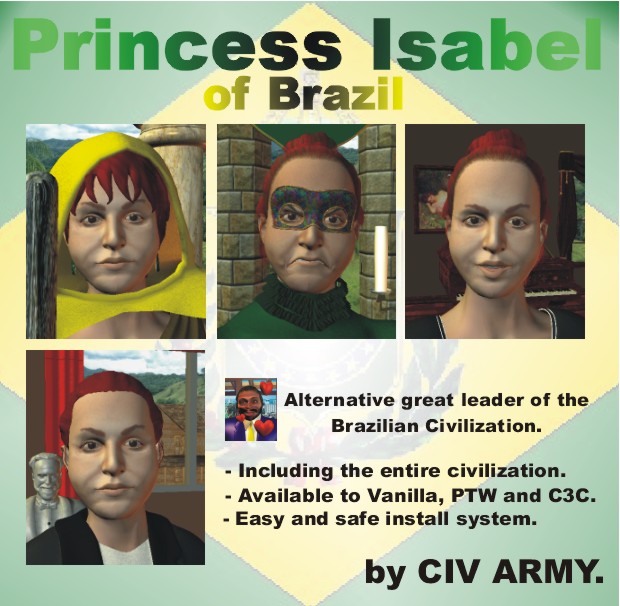
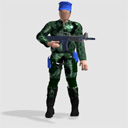





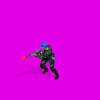
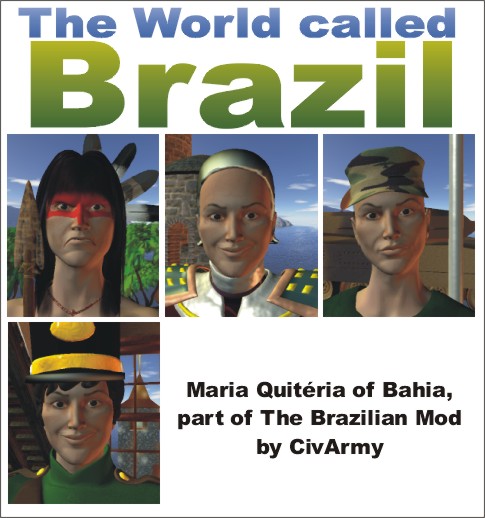



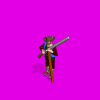
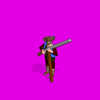
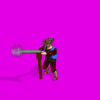
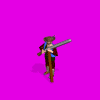
 All these leaders are great ... And you give a complete civ with ... Great work ...
All these leaders are great ... And you give a complete civ with ... Great work ... 
 .
.